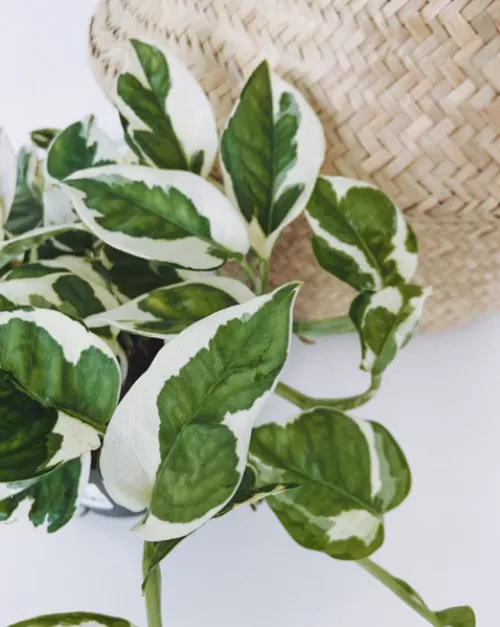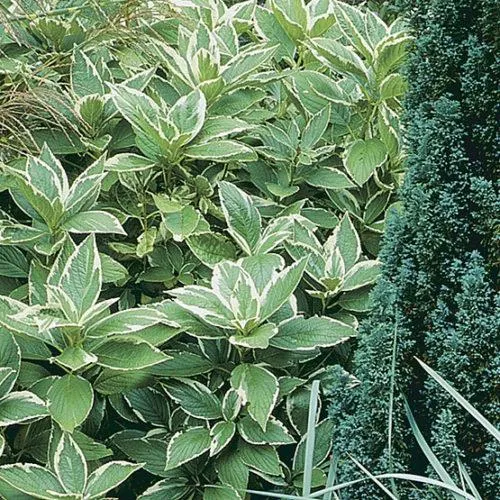Your Guide to Green and White Variegated Houseplants
If you’re looking for foliage with interesting color patterns to brighten up your home, green and white variegated plants are certainly worth considering. The contrasting green and white or cream leaves add visual appeal. In this article, I’ll provide an overview of some popular variegated plant options, care tips, and answers to other questions you may have.
What is a Variegated Plant?
Variegation refers to differences in coloration within leaves, stems or flowers that are otherwise normally a uniform color (National Gardening Association, 2021). The white, cream or yellow sections are caused by a lack of chlorophyll that produces green pigment. Variegation occurs naturally through genetic mutations and is often a desirable characteristic for houseplants.
Popular Green and White Variegated Plant Varieties
- Chinese Evergreens (Aglaonema): Extremely easy to care for with thick, leathery leaves in various variegated patterns. Great for low-light areas.
- Zebra Plant (Haworthia attenuata): Small succulent with stiff, stripey leaves. Very low maintenance and drought tolerant.
- Peperomia: Comes in many varieties with round, oval or heart-shaped leaves marked by cream or white. Some varieties thrive in low light.
- Pothos or Devil’s Ivy (Epipremnum aureum): Vining plant ideal for hanging baskets. Variegated leaves come in green, yellow and white shades.
- Philodendron: Huge range of heart-shaped or lobed leaves adorned in white markings. Some varieties can grow quite large.
Care Tips for Variegated Plants
While variegated plants are generally low maintenance, here are some tips from my experience to keep them looking their best:

- Place in medium to bright, indirect light to maintain vibrant colors without sunburn.
- Water when top 1-2 inches of soil is dry. Most variegated plants are epiphytic or succulent types that prefer drier soil.
- Fertilize in spring and summer with a diluted, all-purpose plant food.
- Trim off any brown or sparse leaves to promote new growth and fuller appearance.
- Repot only when roots emerge from the drainage holes, using a well-draining potting mix.
- Watch for signs of pests and treat promptly to prevent damage.
The challenge is finding the right balance of light and water for each variety. patience and observation are key – and impressively, some species are very forgiving of mistakes!
Is Variegation Permanent?
A common concern gardeners have is whether the unique variegated patterns will remain stable or revert back to solid green over time. In most cases, the variegation is permanent when propagated from stem or leaf cuttings of the parent plant. However, there is a small chance of genetic “sporting” where a new mutation arises. Maintaining optimal growing conditions helps minimize this risk. Cuttings are the safest way to ensure cultivar stability.
Dealing with Less Chlorophyll
Since variegated plant parts contain less chlorophyll for photosynthesis, they may grow more slowly or struggle in very low light. The white sections are also more prone to sunburn or scorching if suddenly exposed to direct sun indoors. Rotting can also be an issue if these areas stay constantly wet or humid. Careful acclimation periods help prevent such problems. Despite requiring special care, variegated plants’ appealing looks make the extra effort worthwhile!

Personal Favorite Variegated Plants
Two varieties I’ve had success with in my own home are Pothos and Chinese Evergreens. Pothos is practically indestructible – even surviving my clumsy overwatering as a new plant parent! Its trailing stems look amazing draped along a bookshelf. Chinese Evergreens have been a riot of intricate color patterns to admire. I just give them a sunny spot and ignore them very successfully, basically! Their hardiness and low fuss factor make them totally rad.
Conclusion
In conclusion, green and white variegated plants offer a cool, modern aesthetic to dress up your living space. Explore the many varieties to find the right low-maintenance options for your light and care preferences. With some observation skills and simple adjustments over time, their unique markings can be retained for seasons of enjoyment. Do let me know if you have any other questions as you start to research and pick out new variegated additions for your plant family!
Key Features of Variegated Plants
| Plant Type | Light Needs | Water Needs | Care Tips |
|---|---|---|---|
| Spider Plant | Bright Indirect Light | Allow Soil to Dry Between Waterings | May Drop Variegated Leaves if Overwatered |
| Chinese Evergreen | Medium Light | Water When Top 1″ of Soil is Dry | Prone to Mealybugs if Soil Stays Too Dry |
| Peperomia | Bright Indirect Light | Allow Soil to Dry Before Watering | Trim Off Brown Tips to Encourage New Growth |
| Philodendron | Medium to Bright Light | Water When Top inch of Soil is Dry | May Become Less Variegated if Grown in Low Light |
| Pothos | Low to Medium Light | Allow Soil to Dry Between Waterings | Snip Off Brown Tips to Encourage New Growth |
FAQ
-
What causes green and white variegated leaves?
The leaves are variegated due to a genetic mutation. The plant is unable to produce chlorophyll in certain areas, so those parts remain white while the surrounding tissue stays green and photosynthetic. Basically, it’s a quirk of nature rather than anything the plant does on purpose.

-
Will the variegated pattern stay the same or change over time?
The variegation is generally stable but sometimes the amount of white compared to green can sort of change from year to year on the same plant. Stress factors like too much or too little light might cause more white to show. It appears the pattern is also influenced by growing conditions and season. So the plant may look a little different each spring.
-
Do variegated plants grow more slowly?
Often yes, the variegated types will develop more slowly than their solid green counterparts. That’s because the white sections can’t photosynthesize, so the plant has less leaf area to produce energy and nutrients. At the same time, the muted variegated colors also mean less chlorophyll. As a result, variegated plants may stay smaller or take longer to mature.
-
Will the variegation carry over if I propagate from cuttings?
When propagating from cuttings, the new plant should maintain the same variegation pattern as the parent. However, occasionally a reversion can occur where the new growth comes back solid green. But most botanists think this is pretty rare. The variegation seems to be genetically determined, so cuttings usually preserve those traits. I guess there’s also a small chance the new plant might showcase even more dramatic white patterns!

-
How do I keep a variegated plant looking its best?
Give any variegated plant optimal growing conditions with fertile soil, adequate sunlight but not too much, and consistent moisture. High stress can cause more chlorosis or reversion. It also helps to prune away any green reversions that sprout. That way the plant directs more energy to its naturally variegated form. Proper care will reward you with a stunning display of contrasting colors year after year.
-
Are variegated plants valuable or collectible?
Some rare or unusual variegated types have become kind of collectible over time. But most are not significantly more valuable than their solid colored cousins. The value depends a lot on the individual cultivar. Generally though, variegated plants are grown more for their awesome aesthetic appeal than investment potential. The real payoff comes from enjoying their beauty in your own garden!
